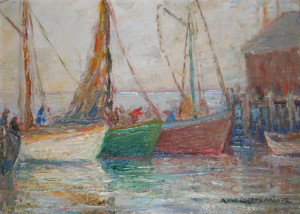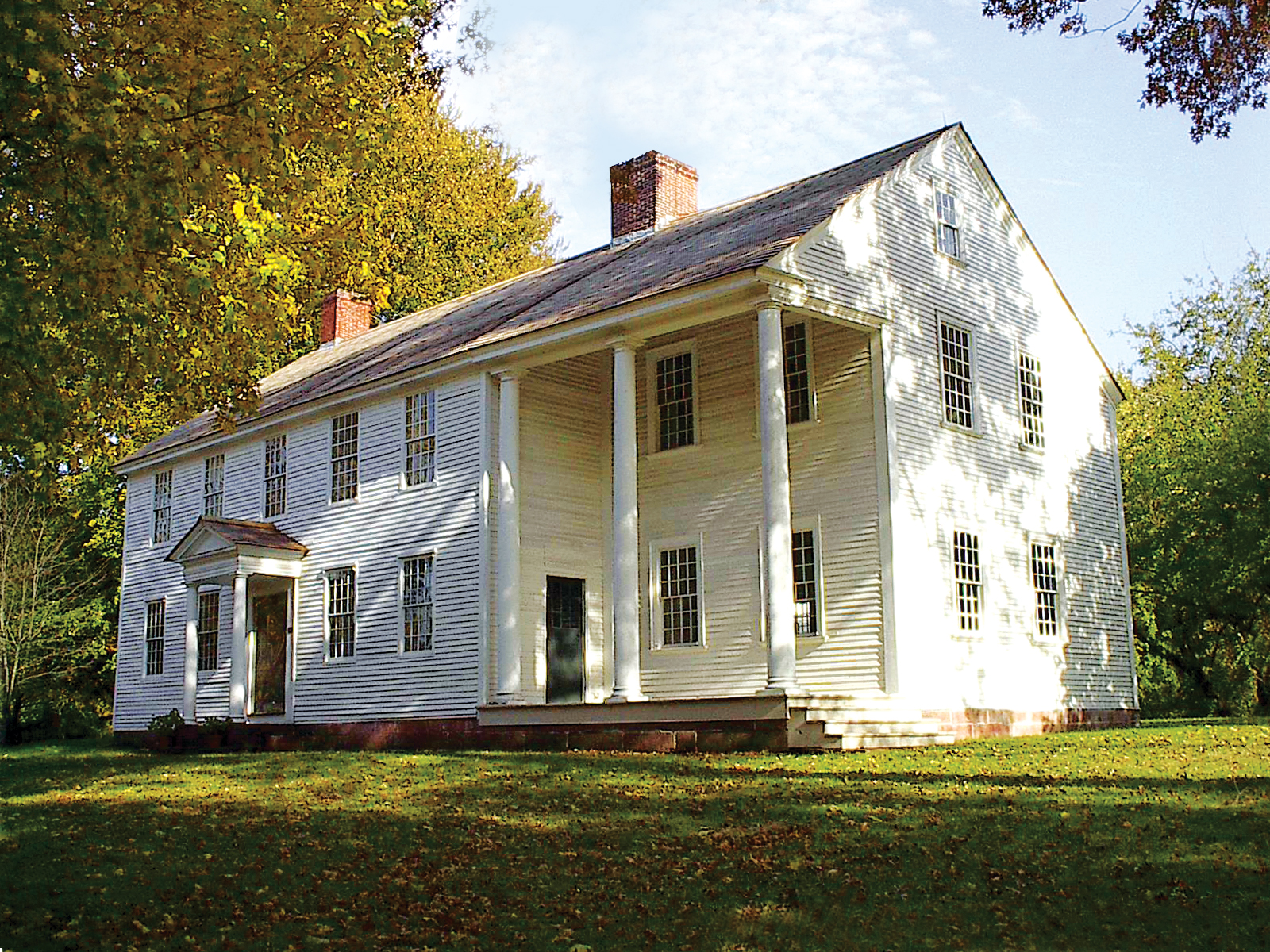By William Hosley
(c) Connecticut Explored. Fall 2015
Subscribe/Buy the Issue!
One of the irrepressible joys of doing local history—of working the content underfoot in a place like Connecticut—are the occasions on which you turn over a stone and make a remarkable discovery.
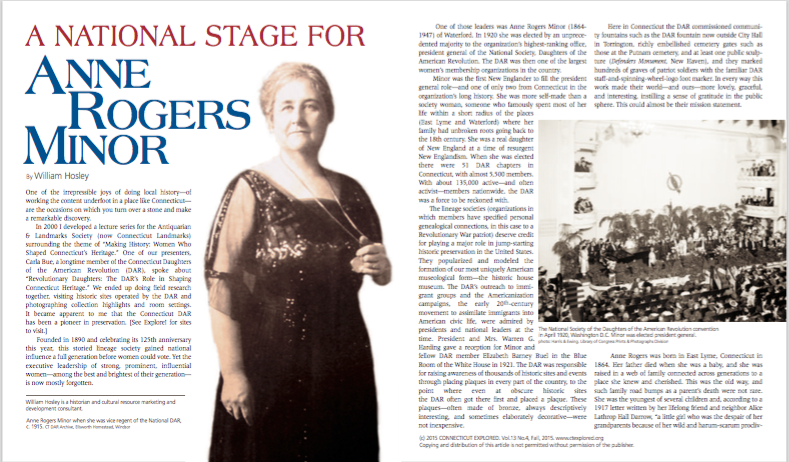 In 2000 I developed a lecture series for the Antiquarian & Landmarks Society (now Connecticut Landmarks) surrounding the theme of “Making History: Women Who Shaped Connecticut’s Heritage.” One of our presenters, Carla Bue, a longtime member of the Connecticut Daughters of the American Revolution (DAR), spoke about “Revolutionary Daughters: The DAR’s Role in Shaping Connecticut Heritage.” We ended up doing field research together, visiting historic sites operated by the DAR and photographing collection highlights and room settings. It became apparent to me that the Connecticut DAR has been a pioneer in preservation. [See Explore! for sites to visit.]
In 2000 I developed a lecture series for the Antiquarian & Landmarks Society (now Connecticut Landmarks) surrounding the theme of “Making History: Women Who Shaped Connecticut’s Heritage.” One of our presenters, Carla Bue, a longtime member of the Connecticut Daughters of the American Revolution (DAR), spoke about “Revolutionary Daughters: The DAR’s Role in Shaping Connecticut Heritage.” We ended up doing field research together, visiting historic sites operated by the DAR and photographing collection highlights and room settings. It became apparent to me that the Connecticut DAR has been a pioneer in preservation. [See Explore! for sites to visit.]
Founded in 1890 and celebrating its 125th anniversary this year, this storied lineage society gained national influence a full generation before women could vote. Yet the executive leadership of strong, prominent, influential women—among the best and brightest of their generation—is now mostly forgotten.
One of those leaders was Anne Rogers Minor (1864-1947) of Waterford. In 1920 she was elected by an unprecedented majority to the organization’s highest-ranking office, president general of the National Society, Daughters of the American Revolution. The DAR was then one of the largest women’s membership organizations in the country.
Minor was the first New Englander to fill the president general role—and one of only two from Connecticut in the organization’s long history. She was more self-made than a society woman, someone who famously spent most of her life within a short radius of the places (East Lyme and Waterford) where her family had unbroken roots going back to the 18th century. She was a real daughter of New England at a time of resurgent New Englandism. When she was elected there were 51 DAR chapters in Connecticut, with almost 5,500 members. With about 135,000 active—and often activist—members nationwide, the DAR was a force to be reckoned with.
The lineage societies (organizations in which members have specified personal genealogical connections, in this case to a Revolutionary War patriot) deserve credit for playing a major role in jump-starting historic preservation in the United States. They popularized and modeled the formation of our most uniquely American museological form—the historic house museum. The DAR’s outreach to immigrant groups and the Americanization campaigns, the early 20th-century movement to assimilate immigrants into American civic life, were admired by presidents and national leaders at the time. President and Mrs. Warren G. Harding gave a reception for Minor and fellow DAR member Elizabeth Barney Buel in the Blue Room of the White House in 1921. The DAR was responsible for raising awareness of thousands of historic sites and events through placing plaques in every part of the country, to the point where even at obscure historic sites the DAR often got there first and placed a plaque. These plaques—often made of bronze, always descriptively interesting, and sometimes elaborately decorative—were not inexpensive.
Here in Connecticut the DAR commissioned community fountains such as the DAR fountain now outside City Hall in Torrington, richly embellished cemetery gates such as those at the Putnam cemetery, and at least one public sculpture (Defenders Monument, New Haven), and they marked hundreds of graves of patriot soldiers with the familiar DAR staff-and-spinning-wheel-logo foot marker. In every way this work made their world—and ours—more lovely, graceful, and interesting, instilling a sense of gratitude in the public sphere. This could almost be their mission statement.
Anne Rogers was born in East Lyme, Connecticut in 1864. Her father died when she was a baby, and she was raised in a web of family connected across generations to a place she knew and cherished. This was the old way, and such family road bumps as a parent’s death were not rare. She was the youngest of several children and, according to a 1917 letter written by her lifelong friend and neighbor Alice Lathrop Hall Darrow,
a little girl who was the despair of her grandparents because of her wild and harum-scarum proclivities. She did not like to play with dolls, nor help with household duties, nor sew, nor do any of the things that good little girls were supposed to do—and what is more, she consistently refused to do them! … her joy was to share the sports of her brothers; … to go fishing and to shoot ducks; to ride a bicycle; to drive horses, when horses were the things to drive, and later drive automobiles.
She caught the art bug at a time of unprecedented public interest in art, especially for women, as “decorative arts societies” and art academies proliferated in the wake of the 1876 Centennial Exhibition in Philadelphia, though it is not known if she was a member of one. She studied informally, perhaps as early as 1876, under her renowned artist cousin Henry Pember Smith (1854-1907), who continued to summer in and paint images of their Waterford locality long after departing for a degree of fame and fortune in the New York art world. She studied with Henry Ward Ranger in Old Lyme and others.
But Rogers was not just an artist. She was, in every sense, a “New Woman”—a feminist ideal that emerged in the late 1890s that described the educated, independent career women in Europe and the United States—women who pushed the limits. Rogers was avowedly a suffragist, though the right to vote was not her main concern. The essential achievement of this new breed of women was personal liberty.
In 1888 Rogers made her mark in real estate, jumping, out of economic necessity, into the booming coastal resort economy of the Gilded Age. That year she opened the Konomoc Inn on the Niantic River in Waterford, described in the 1898 Biographical Review for New London County as “one of the most popular summer hotels on the Sound.” She became a skillful and effective businesswoman, buying and selling properties. In 1895, at age 31, at a ceremony at her inn, she married Dr. George Maynard Minor.
After her marriage she managed the accounts of her physician husband, got deeply involved in the DAR, and continued working as an artist, showing her work at the Connecticut Academy of Fine Arts in 1917 and the New Haven Paint and Clay Club in 1920. Her April 1922, one-woman show at the Arts Club of Washington (founded in 1916) brought her national attention.
After the 1905 death of her only child, a two-year-old son named George, Minor stepped into a new sphere of activity in 1909 with her longtime friend and colleague Elizabeth Barney Buel of Litchfield, who served as the DAR’s state regent or vice regent continuously from 1909 to 1925.
Minor and Buel were responsible for one of the Connecticut DAR’s greatest accomplishments: envisioning, compiling, and producing La Guida, a guidebook for Italian immigrants. First published in 1910, it was subsequently issued in multiple languages. Better known as The Guide for Immigrants, it became the model on which the National Society issued the DAR Manual for Citizenship in 1920, when Minor became president general. That book remains in use today, with 12 million copies printed and distributed freely at Ellis Island and other points of immigrant naturalization. Envisioned at the height of the largest boom in immigration in the nation’s history, its timeliness was magnified by World War I, the “red scare,” and the rising anti-immigrant fervor that lead to the Emergency Quota Act (1921) and The National Origins Act (1924).
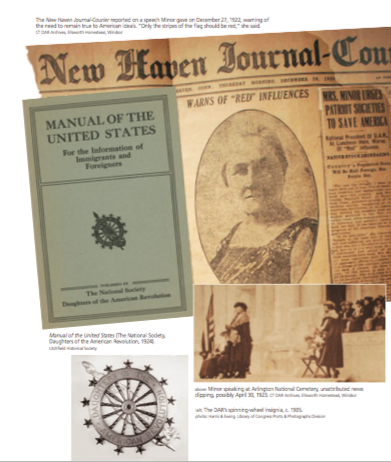 In 1917, the Ruth Wyllys Chapter of the DAR in Hartford offered a course of free public lectures about “civic subjects” at the Old State House “to afford to young and old such advantages as shall develop in them the largest capacity for performing the duties of American citizenship.” College professors were engaged to speak about “Americanization,” “Home Rule,” “The Value in a Community of a Public Forum,” and “Epochs in the Development of American Cities.”
In 1917, the Ruth Wyllys Chapter of the DAR in Hartford offered a course of free public lectures about “civic subjects” at the Old State House “to afford to young and old such advantages as shall develop in them the largest capacity for performing the duties of American citizenship.” College professors were engaged to speak about “Americanization,” “Home Rule,” “The Value in a Community of a Public Forum,” and “Epochs in the Development of American Cities.”
With America’s entry into World War I in April 1917, Minor’s speech-making intensified. In February of that year, the Connecticut DAR announced in a letter to President Woodrow Wilson and Connecticut Governor Marcus Holcomb that “5000 Daughters Ready to Serve State and Nation.” In an address at the DAR’s national convention the month the United States entered the war, Minor spoke before a packed hall, outlining the political platform adopted by the DAR. Later that year, as reported in The Hartford Courant (November 24, 1917), she lectured against pacifists: “We feel there has been too much laxity on the part of our National Government in dealing with pacifists, spies, pro-Germans, and other traitors, and also with enemy aliens … 5,000 Connecticut DAR … urge our state and national governments to take the most strident measures afforded … for the protection of our country from this peril within our gates.” At the national convention in Washington in April 1920, Minor, already in her second term as vice president general of the National Society, became the first president general elected with no opposition.
During her tenure as president general, from 1920 to 1923, Minor traveled extensively, lecturing at DAR state conventions. Along the way she became increasingly engaged in world politics. In New York in 1920 she gave a speech calling on the “DAR to Fight Bolshevism in All Its Forms.” She declared, as The Saratogan reported October 7, 1920, that “arrayed with all its powers against Bolshevikism, … the 112,000 women of the DAR will fight that enemy of America with renewed courage this year.” At a DAR gathering in Grand Rapids, Michigan she said, “It behooves every all-American woman, to get to work against the forces of destruction that threaten to engulf all we hold most sacred. …We must put a stop to the Soviet ideal.”
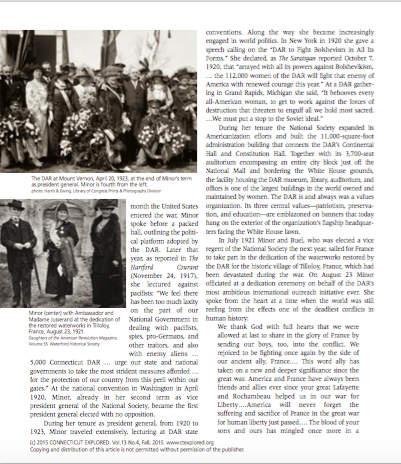 During her tenure the National Society expanded its Americanization efforts and built the 11,000-square-foot administration building that connects the DAR’s Continental Hall and Constitution Hall. Together with its 3,700-seat auditorium encompassing an entire city block just off the National Mall and bordering the White House grounds, the facility housing the DAR museum, library, auditorium, and offices is one of the largest buildings in the world owned and maintained by women. The DAR is and always was a values organization. Its three central values—patriotism, preservation, and education—are emblazoned on banners that today hang on the exterior of the organization’s flagship headquarters facing the White House lawn.
During her tenure the National Society expanded its Americanization efforts and built the 11,000-square-foot administration building that connects the DAR’s Continental Hall and Constitution Hall. Together with its 3,700-seat auditorium encompassing an entire city block just off the National Mall and bordering the White House grounds, the facility housing the DAR museum, library, auditorium, and offices is one of the largest buildings in the world owned and maintained by women. The DAR is and always was a values organization. Its three central values—patriotism, preservation, and education—are emblazoned on banners that today hang on the exterior of the organization’s flagship headquarters facing the White House lawn.
In July 1921 Minor and Buel, who was elected a vice regent of the National Society the next year, sailed for France to take part in the dedication of the waterworks restored by the DAR for the historic village of Tilloloy, France, which had been devastated during the war. On August 23 Minor officiated at a dedication ceremony on behalf of the DAR’s most ambitious international outreach initiative ever. She spoke from the heart at a time when the world was still reeling from the effects one of the deadliest conflicts in human history:
We thank God with full hearts that we were allowed at last to share in the glory of France by sending our boys, too, into the conflict. We rejoiced to be fighting once again by the side of our ancient ally, France…. This word ally has taken on a new and deeper significance since the great war. America and France have always been friends and allies ever since your great Lafayette and Rochambeau helped us in our war for Liberty….America will never forget the suffering and sacrifice of France in the great war for human liberty just passed…. The blood of your sons and ours has mingled once more in a common cause—the same dear cause of liberty. … All America felt this, it is true, but the National Society of the Daughters of the American Revolution had a peculiar and unique reason for responding. …Our ancestors were the men who fought in the War of the American Revolution … were the men that Lafayette came from France to help in their fight for freedom. …These waterworks betoken the friendship, the gratitude the love which our Society bears to France today, and which our ancestors bore to Lafayette….
In April 1923, at age 59, Minor retired from national office, withdrawing to her beloved “Riverby” estate on the Keeney Cove branch of the Niantic River, where she focused on state and local affairs for the next 24 years.
In 1917 Minor was appointed by Governor Holcomb to the board of directors that in 1918 established the Connecticut State Farm for Women, later renamed the Niantic Correctional Institution and since 1996 known as York Correctional Institution—the state’s first prison for women. Initially the inmates worked to support the farm and lived in dormitories in an atmosphere of relative freedom involving chores, classes, and recreation. Minor advocated for building a chapel there beginning in 1925 and left a substantial bequest that eventually assured that would happen.
Minor served on the board of Connecticut College for Women and as a trustee of the American International College in Springfield, Massachusetts, where the DAR built a girls’ dormitory in 1925. She was appointed to the Connecticut Tercentenary Commission, which devised an expansive, brilliant, and unprecedented program of pageantry, publication, and celebration in 1935. In the late 1930s she served as president of the New London County Historical Society.
Instilling a sense of gratitude and reverence in the public sphere is the essence of Anne Rogers Minor’s life and legacy. There were no female CEOs in those days. For much of Minor’s life, women couldn’t vote, and women of her mother’s generation had been tied by need and by custom to domestic duties. After the death of her husband George in 1924, she led a life in which place, past, and community were a benediction she served and enriched with passion, vision, and determination.
William Hosley is a historian and cultural resource marketing and development consultant.
NOTE: Unless otherwise noted, this article was based on two main sources: the DAR archives at the Oliver Ellsworth Memorial Museum in Windsor, and Waterford town historian Vivian Brooks’s Anne Belle Rogers Minor: A Masterpiece in Modesty, a richly footnoted and expansive manuscript that she generously shared, saying, “I am just thrilled that a bit of her story will be told.”
ADDENDUM: Vivian Brooks’s Anne Belle Rogers Minor: A Masterpiece in Modesty was self-published in 2020. To purchase a copy, make a donation of $24.50 (includes $4.50 in shipping) to the Lucretia Shaw Chapter DAR and send to the address below. For questions, contact Vivian at 860-391-1384.
Vivian A. Brooks
18 Riverside Drive
Waterford, CT 06385-1414
Explore!
With more than 177,000 members in approximately 3,000 chapters worldwide, the DAR is one of the world’s largest and most active service organizations. The Connecticut DAR supports historic preservation, education, and patriotism. Membership is open to women 18 and older of any race, religion, or ethnic background with a lineal descendant of a patriot who supported the American Revolution. It operates three historic sites open to visitors seasonally, May to October. Visit ctdar.org for more information or follow it on Facebook.com/CTDAR or Twitter.com/ConnecticutDAR
The Oliver Ellsworth Homestead
778 Palisado Avenue, Windsor. 860-643-5718, ellsworthhomesteaddar.org
Ellsworth (1745 – 1807) was a delegate to the Constitutional Convention, one of the five men who drafted the Constitution, and one of the three who proposed the Connecticut Compromise. His contributions to his country did not stop there—learn more at the Oliver Ellsworth Homestead.
Governor Jonathan Trumbull House (closed for renovations in 2015)
and Wadsworth Stable
169 West Town Street, Lebanon. 860-643-3858, govtrumbullhousedar.org
Trumbull (1710 – 1785) was Connecticut’s patriot governor and the only colonial governor to support the American Revolution. The house is the birthplace of John Trumbull, known as America’s Patriot Artist. The Wadsworth Stable, relocated from Hartford in 1954, housed General Washington’s horses when he met with Col. Jeremiah Wadsworth in 1780.

